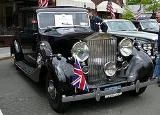
Rolls-Royce Wraith
Encyclopedia
The Rolls-Royce Wraith was built by Rolls-Royce
at their Derby factory from 1938 to 1939 and supplied to independent coachbuilder
s as a running chassis.
The in-line six cylinder, overhead valve, 4257 cc engine was based on that of the 25/30
but featured a cross-flow cylinder head. The four speed gearbox had synchromesh on second, third and fourth speeds and retained the traditional right hand change.
The Wraith featured an independent coil sprung front suspension based on a Packard
120 retaining semi elliptical leaf springs on the rear axle. The hydraulic dampers at the front had their damping rate controlled by governor and so varied with the speed of the car, making it superior to its predecessor, the 25/30 H.P. and on par with the Phantom III
. The car was still built on a separate chassis but this was now of welded rather than the traditional riveted construction. The drum brakes were assisted by a mechanical servo driven by the engine patented by Hispano-Suiza and built by Rolls-Royce under licence. Wire wheels of 17 inch diameter were fitted, with the spokes usually covered by removable discs. A built in hydraulic jacking system was fitted operated by a lever under the passenger seat.
The car could reach 85 mph (136.8 km/h) but this was very dependent on the weight and style of body fitted. On test by "The Motor
" magazine in October 1938 a 0-50 mph time of 16.4 seconds was recorded.
In 1938 the chassis cost £1100 and a typical touring car £1700 complete. 492 chassis were made. Although chassis were only produced in 1939, cars bearing 1940 or later delivery and registration dates are not uncommon. Some cars were finished off during early 1940. Others were held in storage and sold and first registered during the war years. A few were actually bodied during wartime. In addition, 16 prewar chassis were bodied in early 1946 and duly delivered to the government. The final Wraith was delivered in 1947.
(1947) and in a short scene of Johnny Dangerously
(1984).
Rolls-Royce Limited
Rolls-Royce Limited was a renowned British car and, from 1914 on, aero-engine manufacturing company founded by Charles Stewart Rolls and Henry Royce on 15 March 1906 as the result of a partnership formed in 1904....
at their Derby factory from 1938 to 1939 and supplied to independent coachbuilder
Coachbuilder
A coachbuilder is a manufacturer of bodies for carriages or automobiles.The trade dates back several centuries. Rippon was active in the time of Queen Elizabeth I, Barker founded in 1710 by an officer in Queen Anne's Guards, Brewster a relative newcomer , formed in 1810. Others in Britain included...
s as a running chassis.
The in-line six cylinder, overhead valve, 4257 cc engine was based on that of the 25/30
Rolls-Royce 25/30
The Rolls-Royce 25/30 built between 1936 and 1938 is an updated version of the 20/25 with larger engine to provide more power, as often, over-large bodies had been fitted to the earlier model leading to complaints about its performance.-Engineering:...
but featured a cross-flow cylinder head. The four speed gearbox had synchromesh on second, third and fourth speeds and retained the traditional right hand change.
The Wraith featured an independent coil sprung front suspension based on a Packard
Packard
Packard was an American luxury-type automobile marque built by the Packard Motor Car Company of Detroit, Michigan, and later by the Studebaker-Packard Corporation of South Bend, Indiana...
120 retaining semi elliptical leaf springs on the rear axle. The hydraulic dampers at the front had their damping rate controlled by governor and so varied with the speed of the car, making it superior to its predecessor, the 25/30 H.P. and on par with the Phantom III
Rolls-Royce Phantom III
The Rolls-Royce Phantom III was the final large pre-war Rolls-Royce. Introduced in 1936, it replaced the Phantom II and it was the only V12 Rolls-Royce until the 1998 introduction of the Silver Seraph....
. The car was still built on a separate chassis but this was now of welded rather than the traditional riveted construction. The drum brakes were assisted by a mechanical servo driven by the engine patented by Hispano-Suiza and built by Rolls-Royce under licence. Wire wheels of 17 inch diameter were fitted, with the spokes usually covered by removable discs. A built in hydraulic jacking system was fitted operated by a lever under the passenger seat.
The car could reach 85 mph (136.8 km/h) but this was very dependent on the weight and style of body fitted. On test by "The Motor
The Motor (magazine)
The Motor was a British weekly car magazine founded on 28 January 1903....
" magazine in October 1938 a 0-50 mph time of 16.4 seconds was recorded.
In 1938 the chassis cost £1100 and a typical touring car £1700 complete. 492 chassis were made. Although chassis were only produced in 1939, cars bearing 1940 or later delivery and registration dates are not uncommon. Some cars were finished off during early 1940. Others were held in storage and sold and first registered during the war years. A few were actually bodied during wartime. In addition, 16 prewar chassis were bodied in early 1946 and duly delivered to the government. The final Wraith was delivered in 1947.
Movie appearances
Some Rolls Royce Wraith are featured in films such as; My Favorite BrunetteMy Favorite Brunette
My Favorite Brunette is a 1947 movie spoofing movie detectives and the film noir style. Starring Bob Hope and Dorothy Lamour, it also features Lon Chaney, Jr...
(1947) and in a short scene of Johnny Dangerously
Johnny Dangerously
Johnny Dangerously is a 1984 comedy spoof of 1930s' crime/gangster movies. It was directed by Amy Heckerling; its four screenwriters included Bernie Kukoff and Jeff Harris, both of whom previously created the hit TV series Diff'rent Strokes...
(1984).

